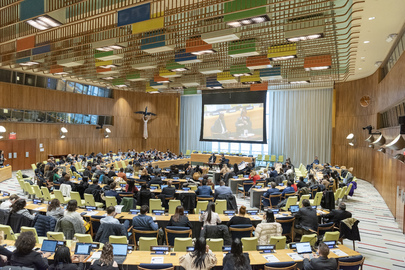With increasing reports of these drones striking civilians in cars, on buses and on public streets, UN monitors have raised serious concerns about potential violations of international humanitarian law.
According to HRMMU’s latest monthly update on the protection of civilians, at least 139 were killed and 738 injured in Ukraine last month. Attacks using short-range drones accounted for almost 30 per cent of these incidents.
“Short-range drones now pose one of the deadliest threats to civilians in frontline areas,” said Danielle Bell, Head of HRMMU.
Terror in the skies
The mission reports that 95 per cent of casualties from short-range drones in January occurred in territory controlled by Ukraine, with the remaining five per cent in areas occupied by Russia.
Many of the attacks involved first-person-view drones, that is, drones equipped with real time cameras, allowing operators to identify and track their targets with precision.
While such technology should, in theory, enable drone operators to distinguish between military and civilian targets, the UN’s findings suggest otherwise.
“Our data shows a clear and disturbing pattern of short-range drones being used in ways that put civilians at grave risk,” Ms. Bell noted.
Deadly incidents on the frontline
The new year brought no respite in frontline regions but rather an escalation and even expansion of the fighting.
Casualties due to short-range drones were responsible for 70 per cent of civilian deaths in the Kherson region, which suffered the highest number of casualties.
One of the most shocking incidents took place on 6 January, when a drone targeted a public transit bus in Kherson City during rush hour. The attack killed a man and a woman and injured eight others.
HRMMU also recorded an increase in drone-related casualties in other frontline regions, including Kharkiv, Sumy, Dnipropetrovsk, Mykolaiv, Donetsk and Zaporizhzhia.
First-hand account of strikes
Survivors have described the moments leading up to these attacks with harrowing detail.
A civilian from Mykolaiv recounted how a small drone circled above his head before diving directly at him while he was working in his home’s garden.
“I realised that I did not have time to hide. I dropped to the ground and covered my head with my hands,” he told HRMMU.
“The blast wave tore off all my clothes. I somehow instinctively tried to protect my eyes. This saved my eyesight, because after the drone explosion, the backs of my palms were covered with small metal fragments, which surgeons later removed. My wedding ring was so pressed into my finger that they had to saw it off to remove it from my finger,” he continued.
A disturbing trend
HRMMU’s data shows a sharp increase in civilian casualties from short-range drones throughout 2024, with a particularly alarming spike in the last six months.
“The on-board cameras should allow operators to distinguish with a higher degree of certainty between civilians and military objectives”, Ms. Bell said, “yet civilians continue to be killed in alarming numbers”.
As Ukraine’s conflict continues, UN monitors have reiterated calls for all parties to take immediate measures to safeguard civilians, in line with international humanitarian principles.
Source of original article: United Nations (news.un.org). Photo credit: UN. The content of this article does not necessarily reflect the views or opinion of Global Diaspora News (www.globaldiasporanews.net).
To submit your press release: (https://www.globaldiasporanews.com/pr).
To advertise on Global Diaspora News: (www.globaldiasporanews.com/ads).
Sign up to Global Diaspora News newsletter (https://www.globaldiasporanews.com/newsletter/) to start receiving updates and opportunities directly in your email inbox for free.





























